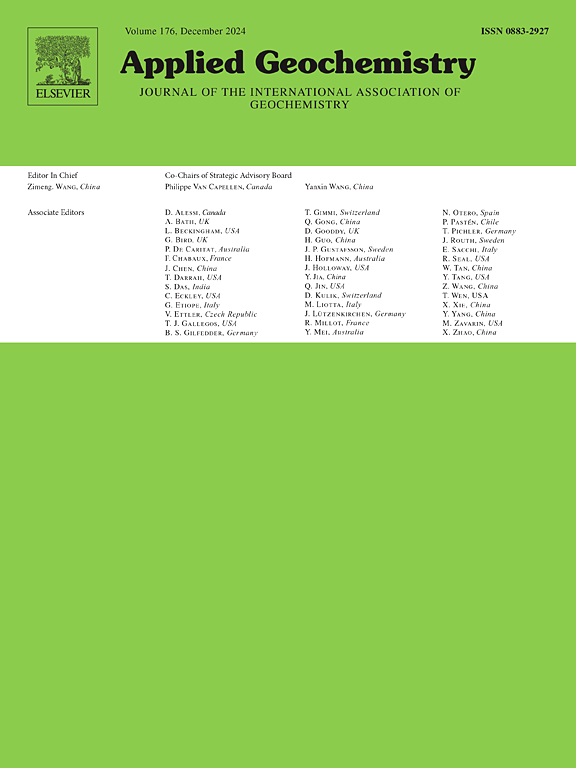Mössbauer光谱学:量化生成h2的岩石中铁的形态和分布的关键工具
IF 3.1
3区 地球科学
Q1 GEOCHEMISTRY & GEOPHYSICS
引用次数: 0
摘要
地下缺氧水对Fe2+的氧化是一个关键的地球化学过程,有助于形成天然二氢(H2)。因此,开发和应用有效的工具来准确表征样品中铁的含量和形态是H2找矿的主要关注点。传统上,对铁的研究要么是在微米尺度上进行耗时的分析,要么是在大块岩石尺度上进行更快的分析,这引起了人们对所选择方法表征的准确性和代表性的担忧。此外,大多数技术通常仅限于确定铁的分布或铁的形态,因此需要进行一系列的分析才能全面了解样品。这种方法不符合H2勘探项目所需的快速和大量表征的需求。在这项研究中,我们通过表征五个富铁的天然样品,研究了Mössbauer光谱(MS)在复杂矿物组合中的相关性。其中,基于所得光谱拟合的质量,我们得出结论,室温(295K)数据收集比低温(6K)数据收集更有效,因为在低温下对混合矿物组合的复杂光谱进行反卷积存在挑战。将质谱法得到的Fe2+/ΣFe比值与常规Fe2+滴定法得到的Fe2+比值进行了比较。对比结果表明,质谱与滴定结果有很大的相关性,Fe2+/ΣFe比值的平均偏差为0.04。这证实了质谱的可靠性,同时提供了对铁分布(即铁矿物学)和铁形态的见解,而不是滴定法,只能获得大块Fe2+/ΣFe比例。最后,结果表明,质谱拟合的准确性受到样品矿物学的先验知识的显著影响,这可以通过快速和常规的表征技术(例如,多光谱矿物成像)很容易地利用。本文章由计算机程序翻译,如有差异,请以英文原文为准。
Mössbauer spectroscopy: a key tool to quantify Fe-speciation and distribution in H2-generating rocks
Oxidation of Fe2+ by anoxic water in the subsurface is a key geochemical process, contributing to the formation of natural dihydrogen (H2). The development and application of effective tools to accurately characterize the content and speciation of iron in samples is thus a major concern for H2 prospection. Traditionally, the study of iron has been conducted through either time-consuming analyses at the micrometer scale or faster analyses at the bulk rock scale, raising concerns about the accuracy and representativeness of the characterization depending on the chosen approach. Moreover, most techniques are typically limited to determining either Fe distribution or Fe speciation, thus necessitating a full series of analyses to reach a comprehensive understanding of the sample. This approach does not align with the need for rapid and numerous characterizations required in H2 prospection programs. In this study, we investigated the relevance of using Mössbauer Spectroscopy (MS) on complex mineral assemblage, by characterizing five Fe-rich natural samples. Among others, we conclude, based on the quality of the resulting spectra fitting that room-temperature (295K) data collection is more effective than low-temperature (6K) data collection, due to the challenges in deconvoluting the complex spectra of mixed mineral assemblages at low temperature. Fe2+/ΣFe ratios obtained from MS are compared with those derived from conventional Fe2+ titration on the same samples. The comparison shows a great correlation between MS and titration results with an average deviation of 0.04 on the Fe2+/ΣFe ratio. This confirms the reliability of MS, providing at the same time insights into both Fe distribution (i.e., Fe mineralogy) and Fe speciation, contrary to titration that only gives access to bulk Fe2+/ΣFe ratio. Finally, results show that the accuracy of MS spectra fitting is significantly influenced by prior knowledge of the sample mineralogy, which can be easily leveraged by rapid and routinely performed characterization techniques (e.g., multispectral mineral imaging).
求助全文
通过发布文献求助,成功后即可免费获取论文全文。
去求助
来源期刊

Applied Geochemistry
地学-地球化学与地球物理
CiteScore
6.10
自引率
8.80%
发文量
272
审稿时长
65 days
期刊介绍:
Applied Geochemistry is an international journal devoted to publication of original research papers, rapid research communications and selected review papers in geochemistry and urban geochemistry which have some practical application to an aspect of human endeavour, such as the preservation of the environment, health, waste disposal and the search for resources. Papers on applications of inorganic, organic and isotope geochemistry and geochemical processes are therefore welcome provided they meet the main criterion. Spatial and temporal monitoring case studies are only of interest to our international readership if they present new ideas of broad application.
Topics covered include: (1) Environmental geochemistry (including natural and anthropogenic aspects, and protection and remediation strategies); (2) Hydrogeochemistry (surface and groundwater); (3) Medical (urban) geochemistry; (4) The search for energy resources (in particular unconventional oil and gas or emerging metal resources); (5) Energy exploitation (in particular geothermal energy and CCS); (6) Upgrading of energy and mineral resources where there is a direct geochemical application; and (7) Waste disposal, including nuclear waste disposal.
 求助内容:
求助内容: 应助结果提醒方式:
应助结果提醒方式:


